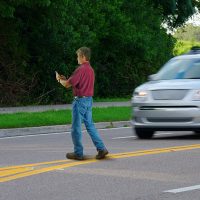Can A Pedestrian Be At Fault For A Car Accident If They Get Struck In Rhode Island?

Contrary to popular belief, car drivers are not always at fault when they hit a pedestrian. In fact, it is important to understand Rhode Island’s traffic laws that apply to pedestrians to determine fault in a motor vehicle accident in which a vehicle hits a pedestrian.
While car drivers have a duty to stay vigilant at all times and take reasonable measures to avoid causing harm to those around them, including pedestrians, pedestrians are also expected to take reasonable precautions to protect their safety.
If you have been involved in a pedestrian accident in Rhode Island, it is vital to consult with an experienced attorney to determine fault in your particular case. Contact a Rhode Island car accident attorney to discuss your unique situation.
When Can a Pedestrian Be at Fault for a Car Accident?
Many drivers and pedestrians alike mistakenly believe that pedestrians always have the right of way. That is not entirely true. While car drivers are responsible for a large percentage of accidents in which they hit a pedestrian, pedestrians can be at fault, too.
For example, if a car driver has the right of way and a pedestrian runs into the path of the vehicle in an unmarked crosswalk, the pedestrian may be partially or fully at fault for the collision. In that situation, the pedestrian may be deemed negligent because they failed to exercise due care.
Common situations in which a pedestrian may be partially or fully at fault for the accident include:
- Crossing the street while distracted by a phone
- Crossing a roadway at any point other than a crosswalk (jaywalking)
- Walking on a restricted roadway
- Entering the roadway while intoxicated
- Crossing the road against the traffic signal
Often, it is necessary to consult with a skilled attorney to determine fault in a pedestrian accident in Rhode Island.
Rhode Island’s Traffic Laws That Apply to Pedestrians
The following traffic laws may be considered when determining fault in a pedestrian accident in Rhode Island.
- The right of way within a crosswalk. Under Rhode Island Gen. Laws § 31-18-3, drivers must yield the right of way to pedestrians crossing the road within a crosswalk when traffic control signals are missing or not working. However, the pedestrian has to be on the half of the road upon which the motor vehicle is traveling. Pedestrians are prohibited from suddenly leaving the curb or walking/running into the vehicle’s path when the car is too close to the pedestrian to yield.
- Crossing outside a crosswalk. Rhode Island Gen. Laws § 31-18-5 requires pedestrians to yield to car drivers when crossing the road outside a marked crosswalk or within an unmarked crosswalk at intersections.
- Crossing between adjacent intersections. Under Rhode Island Gen. Laws § 31-18-7, pedestrians are not allowed to cross between adjacent intersections at any place other than a marked crosswalk as long as traffic control signals are working.
- Drivers must exercise due care. Rhode Island Gen. Laws § 31-18-8 requires drivers to exercise due care when observing a child or a visibly intoxicated, incapacitated, or confused adult on the road. The statute also requires motorists to give audible signs when necessary to avoid accidents.
In most pedestrian accidents, fault is not immediately apparent. Often, a thorough investigation is necessary to determine whether or not a pedestrian can be at fault when they were struck by a vehicle in Rhode Island.
Schedule a case review with our attorneys at Robert E. Craven & Associates to determine fault in your pedestrian accident. Call 603-624-7200 to receive a consultation.
